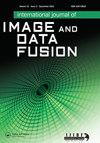Surface drainage features identification using LiDAR DEM smoothing in agriculture area: a study case of Kebumen Regency, Indonesia
IF 1.8
Q3 REMOTE SENSING
International Journal of Image and Data Fusion
Pub Date : 2022-05-17
DOI:10.1080/19479832.2022.2076160
引用次数: 2
Abstract
ABSTRACT Digital Elevation Model (DEM) is the most vital data to generate drainage networks and to provide critical terrain factors and hydrologic derivatives, such as slope, aspect, and streamflow. The accuracy of generated drainage features is extensively dependent on the quality and resolution of DEM, such as LiDAR-derived DEM. Contrary, it has a high level of roughness and complexity. Thus, smoothing methods are sometimes employed to conquer the roughness. This paper presents feature-preserving DEM smoothing (FPDEM-S) and edge-preserving DEM smoothing (EPDEM-S) approaches to smooth surface complexity in kind of preserving small drainage features using the 0.5 m – resolution LiDAR DEM of the Kedungbener River area in Kebumen Regency, Indonesia. Entangling linear morphometric factors, those smoothing approaches delivered a slight difference of stream number, with the FPDEM-S stream length ratio performing 7% better tendencies. The FPDEM-S method perormed better than EPDEM-S in this study area to provide an optimal smoothed LiDAR DEM at certain parameter values. Summarising that two smoothing methods approaches performed similar characteristics of watershed as an oval structure close to the circular shape. Also, it can be revealed that the watershed did not reach maturity phase.基于激光雷达DEM平滑的农业区地表排水特征识别——以印度尼西亚Kebumen Regency为例
数字高程模型(DEM)是生成流域网络和提供关键地形因子和水文衍生物(如坡度、坡向和流量)的最重要数据。生成的排水特征的准确性很大程度上取决于DEM的质量和分辨率,例如lidar衍生的DEM。相反,它具有高水平的粗糙度和复杂性。因此,有时采用平滑方法来克服粗糙度。本文提出了保留特征的DEM平滑(FPDEM-S)和保留边缘的DEM平滑(EPDEM-S)方法,利用印度尼西亚Kebumen Regency的Kedungbener河地区的0.5 m分辨率LiDAR DEM来平滑表面复杂性,以保留小的排水特征。在纠缠线性形态测量因子的情况下,这些平滑方法的流数略有不同,FPDEM-S流长度比的趋势提高了7%。在本研究区域,FPDEM-S方法比EPDEM-S方法表现更好,可以在一定参数值下提供最优的光滑LiDAR DEM。综上所述,两种平滑方法都具有分水岭接近圆形的椭圆形结构的相似特征。同时也可以看出流域尚未达到成熟期。
本文章由计算机程序翻译,如有差异,请以英文原文为准。
求助全文
约1分钟内获得全文
求助全文
来源期刊

International Journal of Image and Data Fusion
REMOTE SENSING-
CiteScore
5.00
自引率
0.00%
发文量
10
期刊介绍:
International Journal of Image and Data Fusion provides a single source of information for all aspects of image and data fusion methodologies, developments, techniques and applications. Image and data fusion techniques are important for combining the many sources of satellite, airborne and ground based imaging systems, and integrating these with other related data sets for enhanced information extraction and decision making. Image and data fusion aims at the integration of multi-sensor, multi-temporal, multi-resolution and multi-platform image data, together with geospatial data, GIS, in-situ, and other statistical data sets for improved information extraction, as well as to increase the reliability of the information. This leads to more accurate information that provides for robust operational performance, i.e. increased confidence, reduced ambiguity and improved classification enabling evidence based management. The journal welcomes original research papers, review papers, shorter letters, technical articles, book reviews and conference reports in all areas of image and data fusion including, but not limited to, the following aspects and topics: • Automatic registration/geometric aspects of fusing images with different spatial, spectral, temporal resolutions; phase information; or acquired in different modes • Pixel, feature and decision level fusion algorithms and methodologies • Data Assimilation: fusing data with models • Multi-source classification and information extraction • Integration of satellite, airborne and terrestrial sensor systems • Fusing temporal data sets for change detection studies (e.g. for Land Cover/Land Use Change studies) • Image and data mining from multi-platform, multi-source, multi-scale, multi-temporal data sets (e.g. geometric information, topological information, statistical information, etc.).
 求助内容:
求助内容: 应助结果提醒方式:
应助结果提醒方式:


